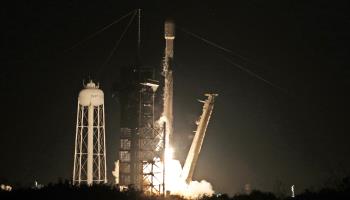Rocket affordability, mineral scarcity and rising geopolitical tension are stimulating interest in space mining
On May 7, US-based company Interlune announced that the Department of Energy (DOE) will buy three litres of helium-3 gas to be mined, processed and shipped from the moon. Mineral enthusiasts are seeking to exploit lower rocket launch costs to explore space mining. However, legal and political hurdles to extraterrestrial mining remain. Geopolitical tensions over ‘critical minerals’ further incentivise the search for alternative supply sources.
What’s next
Subsidiary Impacts
- AstroForge, a California-based asteroid mining firm, plans this year to test its ‘Vestri’ spacecraft to dock on a near-Earth asteroid.
- The proliferation of debris and satellites in space raises risks and costs of space operation, changing the space mining cost/reward mix.
- China’s University of Mining and Technology just unveiled China’s first space mining robot; US-China strains will be high in space mining.
Analysis
The increasing complexity of inputs into modern technologies calls for wider use of minor minerals, many of which are economically available from few geological and geographic sources. The potential for politicisation of mineral supply, plus concerns over environmental damage of mining, further incentivise the search for alternative, reliable sources of supply, just as new applications multiply — from humanoid robotics to electronic warfare.
95%
The reduction in the price of heavy launches to low-Earth orbit over recent decades
In the last five decades the price of heavy launches to low-Earth orbit has fallen from around USD65,000 per kilogram to USD1,500 according to the Aerospace Security Project at the Center for Strategic and International Studies. The proliferation of low-orbit satellites, in combination with the scarcity of critical minerals and growing US-China competition, are prompting innovators to explore the possibility of extracting mineral resources from potentially accessible celestial bodies.
The moon
Interune’s agreement with the US Department of Energy (DOE) to provide the lunar-processed helium-3 — a gas used as a coolant in quantum computing as well as in nuclear fusion exploration — and to do so by April 2029 comes after earlier grants from DOE and NASA to develop lunar mining and extraction techniques.
The moon’s craters are thought to contain potentially significant deposits of metal oxides — rare earths, scandium, titanium and aluminium. Other minerals present include beryllium, lithium, tantalum, enriched potassium, zirconium and niobium. Non-metal minerals include phosphorus, feldspar and metalloids such as silicon.
Moon mining could prove relatively straightforward. Much of the material is located in regolith, close to the surface. Extraction would operate in a low gravity environment, making hoisting of heavy material less energy intensive, although the machinery employed would have to withstand temperature extremes between lunar day and night.
However, substantial challenges persist — the need to operate everything remotely with signal lag, inaccessibility for repairs and the risk of regolith damaging machinery.
Key local inputs
Before mineral mining can begin, extractive activity must locally find, secure and adapt the water, oxygen and energy resources needed:
- Water is key to concentrating mined ores via hydrometallurgical methods. It could be obtained by heating lunar ice, found in permanently shaded craters near lunar poles, and could serve as a source of hydrogen and oxygen, for rocket fuel and life support.
- Oxygen could also be extracted from the moon’s near surface oxides.
- Energy requirements could be addressed by solar installations.
In decades ahead, the availability of non-radioactive helium-3, which is rare on earth but abundant on the moon’s surface, could be important. Helium-3 is prized for its potential in nuclear fusion. The moon is not protected by an atmosphere and helium has been accumulated over millennia through direct exposure to solar winds. If nuclear fusion becomes commercially viable at scale, the moon could become a significant fuel source.
Asteroids
Certain asteroids have much higher concentrations of cobalt, nickel and platinum group of metals than are found on Earth. This includes high grades of ruthenium, iridium and osmium, the densest element in the periodic table.
Resources obtained on an asteroid could then be processed locally, or used in orbiting manufacturing facilities, or brought to the moon or to Earth. Bringing them to Earth at scale would be technically tricky and expensive. They would require heat shielding during re-rentry and guidance to land safely.
Challenges
Knowledge of space minerals has been collected over decades by uncrewed missions conducted by Japan’s Hayabusa and by NASA. However, while technology makes mineral exploration relatively simple, actual extraction presents unresolved challenges.
For example, mining methods would have to be developed to deal with fly rock. The terrestrial mining industry uses explosives such as ANFO-ammonium nitrate fuel oil. ANFO has an explosion velocity of 3,200 metres per second. Lunar escape velocity is only 2,400 metres per second. Mining using today’s blasting technology would therefore quickly fill the moon’s orbit with debris.
More futuristic concepts are investigating the possibility of conducting quarrying operations that could transport iron- or nickel-bearing slabs, carved out from an asteroid, back to Earth without a spacecraft or capsule. This type of mining would resort to shaped charge explosives in lieu of conventional drilling and blasting methods. Separately, NASA is working on collaborative robots that could conduct mining-related activities on hazardous terrain without satellite positioning systems.
Environmental and legal concerns
As in the case of seabed mining, large-scale extractive activity in space would not be environmentally benign (see INT: Seabed mining to advance despite climate risks – November 3, 2023). The longer-term impact is poorly understood. Frequent returns to Earth by spaceships propelled with currently available fuels could risk further damaging the ozone layer. This problem could potentially be addressed by hydrogen-powered engines. NASA has used hydrogen in the past.
There are also open legal questions regarding the exploitation of resources on “celestial bodies”. The 1967 Outer Space Treaty is somewhat outdated in its idealistic conviction that resources exploited there should be “carried out in the interests of all countries”. The 1979 Moon Agreement has not even been ratified by the dominant powers with viable space programmes. Countries have instead passed their own legislation.
In 2015 the US Commercial Space Launch Competitiveness Act was signed, allowing private citizens to “own, transport, use and sell” the resources found in outer space. This was intended to stimulate nascent investment in space mining by reassuring private firms that they would have legal ownership of any resources they extract. Other major economies have also passed similar laws.
The risk of clashes between competing national laws is high
The 2020 Artemis Accords, drafted by the United States to provide guidelines for activity on the moon, have been ignored by China and Russia. The Accords clarify that the extraction of resources from a given area does not amount to a territorial claim.
China
China has been actively exploring the moon for minerals. In 2022, a Chinese robot found in lunar basalt a previously unknown phosphate mineral, later labelled “Changesite-(Y)”. It contains helium-3 isotope. In 2021, Beijing and Moscow signed a memorandum of understanding to jointly build a base on the moon by 2035, near the ice-rich south pole (see CHINA: Space operations will fuel US arms race – April 7, 2025).




